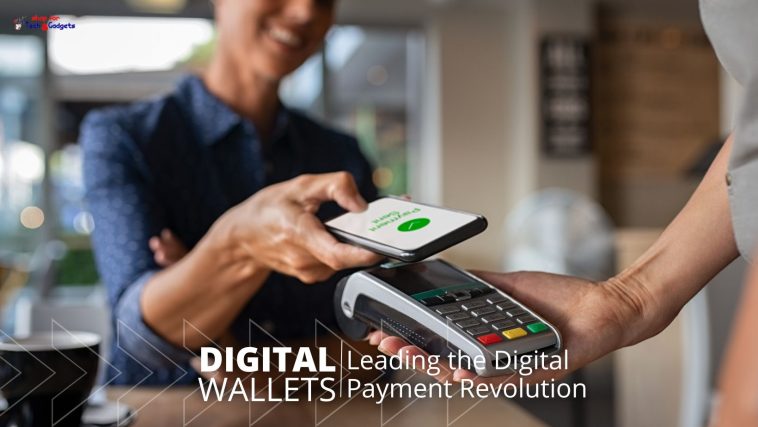The world is rapidly moving toward a cashless society, and digital wallets have become the driving force behind this transformation. With the growing adoption of Apple Pay, Google Pay, and other mobile payment solutions, businesses and consumers alike are experiencing faster, more secure, and more convenient transactions.
Governments and financial institutions across the globe are encouraging digital payments as a way to increase financial inclusion, reduce fraud, and streamline commerce. As technology advances, digital wallets are no longer just a luxury—they are becoming a necessity for everyday transactions, from buying groceries to paying bills and even sending money internationally.
The Evolution of Digital Wallets: A Cashless Future
Digital wallets started as simple payment tools but have evolved into multi-functional financial platforms. Initially, they were designed to store card details and facilitate payments via smartphones. However, today’s digital wallets do much more than just store debit and credit card information.
Modern digital wallets, such as Apple Pay and Google Pay, now support:
- Peer-to-peer (P2P) transfers – Instantly send money to friends, family, or businesses.
- International payments – Seamless cross-border transactions with reduced fees.
- Loyalty and rewards integration – Store and use loyalty points, gift cards, and membership programs.
- Transit and ticketing – Use mobile payments for buses, trains, and event tickets.
- Digital ID and authentication – Store driver’s licenses, student IDs, and even vaccine records securely.
With these expanding capabilities, digital wallets are replacing traditional banking methods and are expected to dominate financial transactions in the coming years.
Apple Pay and Google Pay: Leading the Digital Payment Revolution
Apple Pay: A Seamless and Secure Payment Solution
Apple Pay has become one of the most widely used digital wallets, offering fast, secure, and contactless payments both online and in-store. Users can store their credit and debit cards on their iPhones, Apple Watches, and even Macs, making transactions effortless.
Key Features of Apple Pay:
- Security & Privacy – Uses Face ID, Touch ID, and passcodes for authentication. Transactions are encrypted and do not store card numbers on Apple servers.
- Contactless Payments – Works in millions of stores worldwide, from restaurants to gas stations.
- Online & In-App Purchases – Easily pay on websites and apps without entering card details.
- Apple Pay Later – A Buy Now, Pay Later (BNPL) service allowing users to split purchases into four equal payments without interest.
- Transit & Public Transport – Available in major cities for tap-and-go public transport access.
Apple Pay has continued to expand globally, now supported in over 80 countries, with increasing merchant adoption.
Google Pay: A Versatile Digital Payment Ecosystem
Google Pay (GPay) is another dominant player in the mobile wallet space, offering a more flexible and integrated approach to mobile payments. While Apple Pay is limited to Apple devices, Google Pay works across Android, iOS, and even on desktop browsers, making it a universal solution.
Key Features of Google Pay:
- Cross-Platform Usability – Works on Android phones, tablets, smartwatches, and even iPhones (for online payments).
- Tap to Pay Anywhere – Widely accepted in retail stores, cafes, transit systems, and vending machines.
- P2P Money Transfers – Send and receive money easily between friends and family via Google Pay Send.
- Rewards & Cashback – Exclusive discounts, cashback offers, and promotional deals from major brands.
- Integration with Google Services – Syncs with Google Assistant, Google Maps (for ride payments), and even Google Shopping.
Google Pay has a larger market share in developing countries, particularly in India, where it integrates with the Unified Payments Interface (UPI), making digital payments accessible to millions.
The Benefits of Digital Wallets Over Traditional Payment Methods
1. Faster and More Convenient Transactions
Gone are the days of carrying bulky wallets filled with cash and cards. With a smartphone or smartwatch, users can make payments in seconds—whether at a retail store, online shop, or even a vending machine.
2. Enhanced Security & Fraud Protection
Both Apple Pay and Google Pay use tokenization, which replaces actual card details with a one-time token, reducing the risk of fraud. Biometric authentication (Face ID, fingerprint, or PIN) adds another layer of protection, making transactions more secure than traditional credit cards.
3. Reduced Transaction Fees & International Transfers
Many digital wallets offer lower fees for international transactions compared to banks and traditional remittance services. With features like Google Pay’s UPI integration in India and Apple Pay’s international expansion, sending money abroad is becoming more affordable and efficient.
4. Growing Acceptance & Merchant Integration
Digital wallets are widely accepted at millions of locations worldwide, including restaurants, hotels, airlines, and public transport. As more businesses adopt mobile payments, the demand for cash and even credit cards is shrinking.
5. Integration with Cryptocurrencies and Digital Assets
While Apple Pay and Google Pay do not yet fully support direct cryptocurrency transactions, they are gradually integrating with digital asset platforms. Google Pay has partnered with Coinbase and Binance, allowing users to spend crypto directly via linked cards. Apple Pay also supports crypto-related transactions through third-party apps.
What’s Next for Digital Wallets in 2025 and Beyond?
The future of digital wallets is exciting and transformative. Here’s what we can expect in 2025 and beyond:
- Expansion of Digital ID Services – Apple Pay and Google Pay are working on integrating driver’s licenses, passports, and government IDs into digital wallets.
- More Countries Going Cashless – Governments are actively encouraging digital payments, especially in Scandinavia, China, and India, where cash transactions are rapidly declining.
- Advancements in Wearable Payments – Smartwatches, smart rings, and even smart glasses will further revolutionize the way we make payments.
- Biometric Payment Systems – Future versions of digital wallets could allow fingerprint, retina, or even voice recognition to authorize transactions.
- Deeper AI Integration – Google Pay and Apple Pay may leverage AI to provide financial insights, automate budgeting, and suggest optimized spending habits.
Alternative Digital Wallets You Can Use Anywhere
Besides Apple Pay and Google Pay, there are several other digital wallets that offer unique features and global accessibility. Here are six top alternatives:
1. PayPal (Best for Online Payments & International Transactions)
💳 Accepted in over 200 countries and supports 25+ currencies, making it a leader in online transactions, e-commerce, and international payments.
✅ Features:
- Link multiple bank accounts and credit cards for seamless payments.
- Strong buyer protection for online shopping.
- Peer-to-peer transfers with minimal fees (except for international transactions).
- Crypto support – Buy, sell, and hold Bitcoin, Ethereum, and more.
🌍 Best For: Freelancers, online shoppers, and businesses accepting global payments.
2. Samsung Wallet (Best for Samsung Users)
If you own a Samsung Galaxy device, Samsung Wallet (formerly Samsung Pay) is a great alternative. It offers similar features to Apple Pay and Google Pay but with exclusive perks for Samsung users.
✅ Features:
- MST (Magnetic Secure Transmission) allows it to work with older card readers.
- Secure, contactless payments with Samsung Knox protection.
- Integrated ID storage for loyalty cards and digital passes.
- Cryptocurrency support – Manage and store crypto assets securely.
🌍 Best For: Samsung smartphone users looking for an Apple Pay alternative.
3. Venmo (Best for Social Payments & Splitting Bills)
Venmo (owned by PayPal) is a popular P2P payment app that allows users to send and receive money instantly with a social twist.
✅ Features:
- Instant money transfers between friends and family.
- Social feed for tracking and commenting on transactions.
- Venmo Debit & Credit Card for spending balance in stores.
- Crypto transactions – Buy, sell, and transfer Bitcoin, Ethereum, and more.
🌍 Best For: Friends splitting bills, casual payments, and small businesses.
4. Cash App (Best for Instant P2P Transfers & Investing)
Cash App is a digital wallet + banking + investing platform that allows users to send money, buy stocks and Bitcoin, and even receive direct deposits.
✅ Features:
- Instant P2P money transfers with no fees.
- Bitcoin trading & investing built into the app.
- Cash Card for spending balance at any store.
- Direct deposit & banking features (only in the U.S.).
🌍 Best For: Millennials, crypto users, and those looking for a one-stop financial app.
5. Revolut (Best for Travel & Multi-Currency Payments)
Revolut is a global digital banking app that lets you spend, save, and exchange currencies at real exchange rates—perfect for travelers.
✅ Features:
- Instant currency exchange with 30+ supported currencies.
- Cryptocurrency trading & stock investing.
- Global spending with minimal fees.
- Virtual cards for added security when shopping online.
🌍 Best For: Travelers and those who frequently deal with multiple currencies.
6. Alipay (Best for Asia & Global Shopping)
Alipay is China’s largest digital wallet, with over 1 billion users worldwide. It’s widely accepted in China, Southeast Asia, and global e-commerce platforms.
✅ Features:
- QR code-based payments for fast, secure transactions.
- Global shopping support (works on AliExpress, Taobao, and more).
- Bill payments, transportation, and ticket bookings in one app.
🌍 Best For: Travelers to China and Asia, online shoppers, and business transactions.
Conclusion
The rise of digital wallets like Apple Pay, Google Pay, or one of the many alternatives is changing how we think about money and financial transactions. With increased security, seamless payments, and growing global acceptance, mobile payment solutions are quickly becoming the preferred method for both online and offline transactions.
As technology continues to advance, digital wallets will not only replace cash and cards but also integrate into every aspect of our financial lives. Whether it’s making instant P2P transfers, paying for public transportation, or even managing digital IDs, the future of payments is undoubtedly digital. If you haven’t yet adopted a mobile payment solution, now is the time to explore the convenience and security of Apple Pay and Google Pay.




